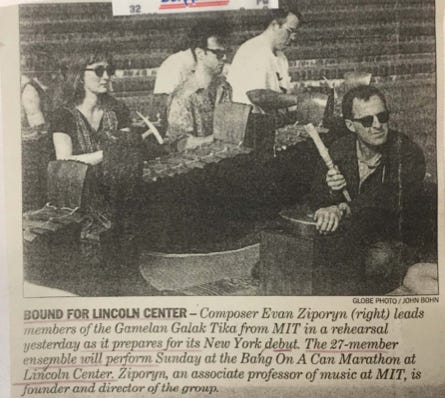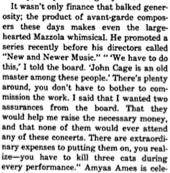
(This is a look.)
Hey folks, thanks for subscribing! It's been encouraging to see all the interest, especially as I figure out what exactly this thing is going to be. As I write this now, I'm thinking about the newsletter as a kind of stream-of-consciousness effort that captures what I'm doing on a day-by-day and week-to-week level, in part as an way for me to be more conscientious about my working process, which I often don't fully consider as it happens, or even remember after it's ended.
So, post-archives, my workstation tends to look a bit like this (I redacted what's actually in my archive notes file -- those are secrets to save for the book!):

Scrivener allows you to import PDFs, but if they're on the larger side they're a bit unwieldy, so I tend to just open my archival materials in Acrobat or Preview. I've OCRed these documents (a new thing for me -- previously I used to just retype text, which is silly), and I copy/transcribe any relevant stuff from the PDF on the left and put it into a Scrivener page on the right devoted to that chunk of archival material. I just recently discovered an amazing intermediary step for this -- https://pastemagic.com -- which gets rid of those incredibly annoying line breaks in scanned/unformatted/old material. I'm sure there's a more efficient way to do this (there always is), but this is the one I've got for now. Things often don't get fully formatted in OCR , so I end up typing out a lot of stuff, but this is valuable for me anyway: retyping passages of text is often what gets the ideas in my head, lodging them in my brain and perhaps eventually into a relevant chapter.
That was the project for the past few days, and it is done! (For the record, that meant going through about 700 pages of scanned material, including critic K. Robert Schwarz’s interview transcripts with Bang on a Can's founders, drafts of his writings on Bang and other topics, and PR materials he had in his personal documents; from Lincoln Center, program brochures, various programming files, and press clippings.) Then I sorted everything into the relevant places. For the chapters I've already drafted, I'm not longer working in Scrivener -- I find the act of writing much easier in Word, so I tend to move things to Word as soon as I start seriously drafting documents -- so I bump chunks of relevant archival material into supplemental Word docs I've created for each chapter, which are filled with stuff that needs to be integrated into subsequent revisions. But the Lincoln Center stuff gets moved into my Scrivener notes on the LC chapter (the one main chapter I still need to write), which looks something like this right now:

FYI, “secret life lincoln center” is a fascinatingly gossipy article from 1980 I found via a George Lewis citation, with tidbits like this:

The next step will be tackling the organization and then writing of that chapter, so I'm going to be delving into those files and moving things around/sorting them/removing them as I figure out what its exact focus and structure will be.
Here's something I learned last week, or at least something I hadn’t fully considered. Lincoln Center looms large in the Bang on a Can mythos -- a renegade organization, at the palace of high culture! -- and it got a lot of press attention, rightfully so, which I'm going to be writing about. It was an Important Moment in 1990s American new music, and arguably a major turning point for Bang on a Can itself. BUT when you look at the hefty Lincoln Center season brochures from the mid-'90s — the archives have tons of them — Bang on a Can has a comparably minuscule presence. Like one little section of one page, amidst listings for a bajillion different concerts. Look at all these different series!! (Sorry, this scan’s a little hard to read.)

These are thick, thick booklets -- and remember, they're only covering what LC itself is presenting, not the Met or NY Phil -- and they make quite evident that Bang is only a tiny part of Lincoln Center's broader story in the 1990s. (Someone should write that book! Not me.) I don't necessarily think I would have put that into perspective without seeing the bigger picture via flipping through the physical brochures themselves: it's not something conveyed by, say, reading New York Times coverage of Bang at Lincoln Center, or interviews with participants, etc etc. Materiality matters! And it's a useful perspective to have, I think, even if it ultimately just yields a parenthetical note in the written chapter itself.

(Young Esa-Pekka!)
The other thing I've been doing, on walks with Georgia and while playing Super Mario Maker 2 (it's pretty fun) is listening to the 27-or-so hours of audio that I obtained at Queens College's K. Robert Schwarz collection. The collection includes CD recordings of a massive number of interviews that Schwarz conducted as a critic/writer in the '90s, which the music library very generously allowed me to rip. (I ripped only a small portion of the full collection.) That means I have original, longform interviews with everyone from Julia Wolfe to Milton Babbitt to Jacob Druckman to Jane Moss, from the actual period I'm writing about. In order to print any quotes from them, I will need permission from both the archive and the interviewee, so you'll not be seeing anything specific from those interviews here -- but so far, listening to them has been totally fascinating.
More on why in the next newsletter, perhaps.



